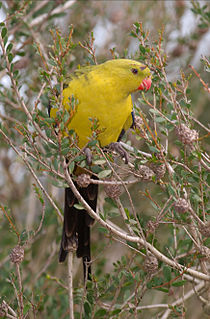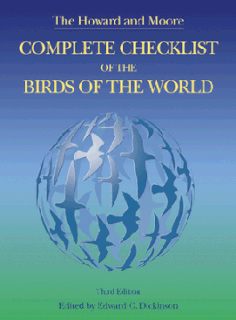
The satin bowerbird is a bowerbird endemic to eastern Australia.

The Royal Australasian Ornithologists Union (RAOU), now part of BirdLife Australia, was Australia's largest non-government, non-profit, bird conservation organisation. It was founded in 1901 to promote the study and conservation of the native bird species of Australia and adjacent regions, making it Australia's oldest national birding association. In 1996, the organisation adopted the trading name of Birds Australia for most public purposes, while retaining its original name for legal purposes and as the publisher of its journal, the Emu. In 2012, the RAOU merged with Bird Observation & Conservation Australia to form BirdLife Australia.

The red-browed pardalote is a small brightly coloured insectivorous passerine, endemic to Australia. A gleaning specialist, they forage primarily in eucalypt trees . The Latin word rubricatus means red-ochred which is descriptive of their orange-red eyebrow. Other common names include red-browed diamondbird, bellbird, cape red-browed, pale red-browed, fawn-eyed, fawn-eyebrowed and pallid or red-lored pardalote.

The regent parrot or rock pebbler is a bird found in southern Australia. It has predominantly yellow plumage with a green tail. The bird is found primarily in eucalyptus groves and other wooded areas of subtropical southwestern Australia, as well as in a smaller area of subtropical and temperate southeastern Australia. Seeds make up the bulk of its diet.

Lewin's honeyeater is a bird that inhabits the ranges along the east coast of Australia. It has a semicircular ear-patch, pale yellow in colour.
Harold James Frith AO was an Australian administrator and ornithologist. He was born at Kyogle, New South Wales and studied Agricultural Science at Sydney University. He first joined the CSIRO Division of Plant Industry but later transferred to the Division of Wildlife and carried out extensive research on malleefowl, waterfowl, especially magpie geese, and pigeons. He eventually became Chief of the Division and was instrumental in proposals that led to the establishment of Kakadu National Park.
Clifford Brodie Frith is a private Australian ornithologist and wildlife photographer. Dr Clifford B. Frith is an English born (1949) Australian citizen and ornithologist. He is an independent zoological researcher, consultant, natural history author, photographer and publisher.
Dr Dawn W. Frith is an English born Australian citizen and ornithologist. She is now a self-employed private, independent, zoological researcher, consultant, natural history author, and publisher.

The white-necked heron or Pacific heron is a species of heron that is found on most of the Australian continent wherever freshwater habitats exist. It is also found in parts of Indonesia, New Guinea and New Zealand, but is uncommon in Tasmania. The populations of this species in Australia are known to be nomadic like most water birds in Australia, moving from one water source to another often entering habitats they have not previously occupied, taking advantage of flooding and heavy rain where the surplus of food allows them to breed and raise their young. Population explosions have been known when the environmental conditions are right for this species in places where they have been rare or unknown.

The grey honeyeater is a species of bird in the honeyeater family. It is an uncommon and little-known bird, an often overlooked endemic of remote areas in central Australia.

The emu-wrens (Stipiturus) are a genus of passerine birds in the Australasian wren family, Maluridae. They are found only in Australia, where they inhabit scrub, heathland and grassland. They are small birds, 12–19 cm long with the tail accounting for over half of their length. The tail has only six feathers which are loose and coarse in structure, rather like the feathers of the emu. Three species are recognised, of which the mallee emu-wren is endangered.

The Howard and Moore Complete Checklist of the Birds of the World is a book by Richard Howard and Alick Moore which presents a list of the bird species of the world. It was the first single-volume world bird list to include subspecies names, and until the publication of the 5th edition of James Clements' Checklist of Birds of the World was the only one to do so.
Richard Schodde, OAM is an Australian botanist and ornithologist.

What Bird Is That? A Guide to the Birds of Australia is a book first published in 1931 by Angus & Robertson in Sydney. Authored and illustrated by Neville William Cayley, it was Australia's first fully illustrated national field guide to birds, a function it served alone for nearly 40 years. In 1960 it was rated the all-time best seller in Australian natural history.

The Mallee-Fowl is a book published by Angus & Robertson in 1962, with the subtitle The Bird that Builds an Incubator. It was authored by Australian ornithologist Harry Frith. It was issued in octavo format, containing 148 pages, bound in dark red cloth with a dust jacket illustrated by a photograph of a malleefowl. The book contains numerous black-and-white photographs by the author, and is dedicated to "Joe".
Birds of Australia: A Summary of Information is a compact handbook on Australian birds published in 1973. It was authored by the originally British ornithologist James David Macdonald who moved permanently to Australia in 1968 following his retirement from a long career with the British Natural History Museum, one of the final responsibilities of which was the organisation of the Harold Hall Australian bird collecting expeditions during the 1960s. The book is dedicated to the sponsor of the expeditions, Australian-born philanthropist Harold Wesley Hall, OBE, MC.
The National Photographic Index of Australian Wildlife was founded as a project of the Australian Museum on 3 June 1969 to compile a comprehensive collection of photographs of Australian bird species. The founder, Donald Trounson, served as the project’s chief executive officer until 1981, when he was succeeded by Ronald Strahan. It was established in association with the National Library of Australia under the direction of a trust chaired by Sir Percy Spender and was the first systematic attempt to compile a comprehensive photographic record of the birds of any country. In 1977 it was expanded to include mammals and, in 1984, reptiles and frogs, with the aim of progressively including other animal groups to become the most comprehensive possible archive of photographs of Australian wildlife and to provide an expanding service to the public, to photographers and to biological science. In November 1980 the Index was incorporated as a part of the Australian Museum and the trust dissolved.
The Roper River scrub robin, also known as the allied scrub robin, is a putative subspecies of the northern scrub robin, a bird in the Petroicidae, or Australasian robin family. Whether it ever existed is doubtful; if it did it is almost certainly extinct.

A Photographic Guide to the Birds of Indonesia is a photographic guide of the birds in Indonesia. It is the only bird book covering the nation as a country with more than 250 million people and more endemic and globally threatened bird species than any other in the world.

Birds of the World: Recommended English Names is a paperback book, written by Frank Gill and Minturn Wright on behalf of the International Ornithologists' Union. The book is an attempt to produce a standardized set of English names for all bird species, and it is the product of a project set in motion at the 1990 International Ornithological Congress. It is supplemented by a website, the IOC World Bird List, giving updates to the published material.













